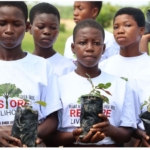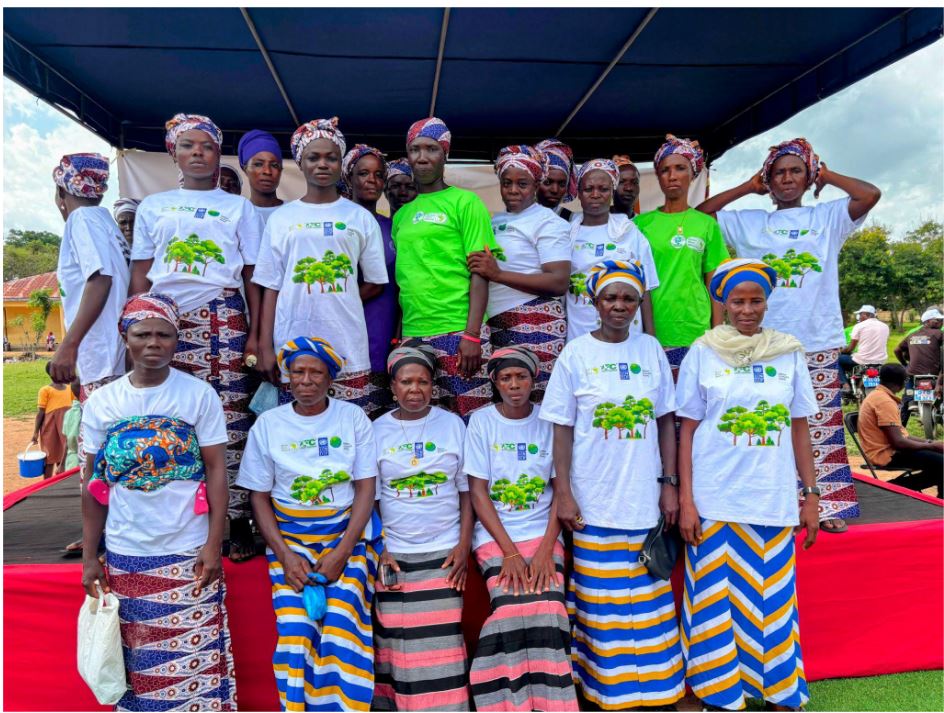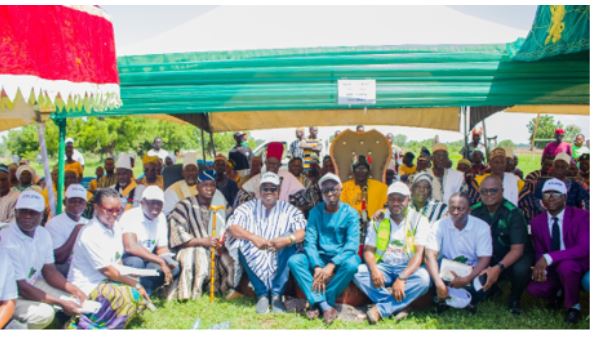
In a landmark show of unity and vision, the chiefs and people of the Sankana traditional area have pledged expansive tracts of land to support the Ghana Shea Landscape Emission Reductions Project (GSLERP), a major shea parkland restoration initiative across 5 northern regions including, Sankana, Takpo, Kaleo and neighbouring communities. The launch of the 2025 seasonal planting, organised by the Global Shea Alliance (GSA), took place in Sankana, Upper West Region, under the banner ‘Plant a Shea Tree, Restore Livelihoods.’
Naa Pagraninge Sakoe Mornah III, Paramount Chief of the Sankana traditional area, delivered powerful remarks as he formally dedicated community land to GSLERP.The project, generously funded by the Green Climate Fund, Government of Ghana and the private sector is being implemented by the Forestry Commission of Ghana in close collaboration with the Global Shea Alliance under UNDP supervision to restore degraded parklands and bolster rural economies through sustainable shea cultivation.
“This day marks more than a ceremonial gathering,” Naa Pagraninge told an audience of more than 800 people, including chiefs, students, CREMA Executives, NGOs and women’s co-operatives. “It
is the beginning of a transformative journey toward economic empowerment, ecological sustainability and the restoration of our beloved shea tree, the ‘Green Gold of the North.’”

Drawing attention to Sankana’s existing infrastructure, including a functional dam, an irrigation network and a vibrant nursery for seedlings with economic and medicinal value, the Paramount Chief described a synergy of tradition and innovation. He envisaged a new era in which young people and women are trained in nursing shea and other high value tree seedlings to ensure a steady supply of quality trees.
A Heritage of Hope
Highlighting the multifaceted significance of the shea tree, Naa Pagraninge referred to it as “a heritage, a healer, a provider and a hope giver.” For generations, shea has supported thousands of households across the Ghanaian savannah belt, offering not only kernels for butter and cosmetic products but also a vital source of income forrural families.
“Our partnership with the GSA could be a game changer,” the chief declared. “Together, we can establish a robust shea growing belt to power industries, uplift rural households and restore degraded lands. You have planted a seed of hope today, may it grow into a mighty tree that will forever shade our lands with prosperity.”
Unwavering Support
Mr Aaron Adu, Managing Director of the GSA, expressed deep gratitude to the Paramount Chief and his subjects for their warm reception and readiness to allocate land. He reaffirmed GSA’s commitment to providing technical support, quality seedlings and market access to ensure that the initiative delivers lasting benefits.
Dr Abdul-Razak Saeed, representing the United Nations Development Programme (UNDP) Country Representative said “UNDP Ghana remains proud in its partnership with the Forestry Commission and the Global Shea Alliance in implementing the Green Climate Fund financed Ghana Shea Landscape Emission Reductions Project (GSLERP). With shea having high value in business, livelihoods and climate change mitigation, this ceremony is one about hope, hope for a greener Ghana, hope for a more inclusive and sustainable economy and hope for future generations.
UNDP takes the opportunity to recognise and salute the women who nurture these trees and keep the industry alive, playing a vital stewardship role over the land and shaping its future.”
Speaking on behalf of the CEO of the Forestry Commission, Dr Hugh Brown, the Managing Director of the Forestry Commission, Mr Kwame Oteng Awuah, urged traditional leaders, farmers, young people and women’s groups to ‘’continue your vital roles in protecting and nurturing the trees, ensuring the long-term success of this shared effort. Together we are building a greener, more resilient Ghana, one shea tree at a time.’’

He expressed deep gratitude to the project’s funders Green Climate Fund and UNDPand commended the Global Shea Alliance and the Forestry Commission for their leadership in implementing GSLERP.
Additionally, traditional leaders in attendance, including chiefs from Takpo, Nanville, Kaleo and Zang, pledged to dedicate land across more than 150 communities. Their collective action underscores the scale and ambition of the campaign, which targets the distribution and transplanting of tens of thousands of tree seedlings over the coming planting season.
Looking Ahead
As the shea planting season unfolds, emphasis will be placed on capacity building workshops for farmers, nursery expansion and the development of co-operative marketing structures. Project co-ordinators anticipate that the restored shea parklands will serve as carbon sinks, enhance biodiversity and deliver a reliable cash crop for rural families.
Observers say that the Sankana launch represents a milestone in climate smart agriculture and rural development in Ghana and could serve as a model for other shea growing regions
across West Africa, reinforcing the region’s reputation as the world’s primary source of shea products.
With land pledged, seedlings primed and communities motivated, the 2025 shea planting season promises to sow more than trees, it will nourish the hopes and livelihoods of thousands across Ghana’s savannah belt.
Conclusion
GSLERP is one of several initiatives contributing to the goals of the Global Shea Alliance’s Action for Shea Parklands (ASP) (www.actionforshea.com). ASP aims to restore and protect the shea parklands by promoting sustainable land management, increasing tree cover and strengthening local livelihoods.
Through this initiative, the GSA and its partners have committed to growing over 10 million shea and other native trees and protecting 4 million hectares of shea parklands by 2030, providing direct support to women co-operatives, young people and local governments working to reverse land degradation.
Projects like GSLERP are helping to deliver these ambitious goals and advance long-term solutions for resilient ecosystems and thriving shea communities.